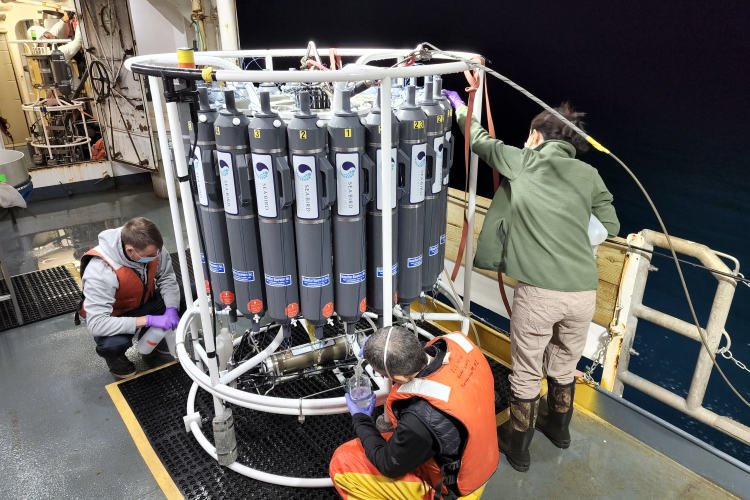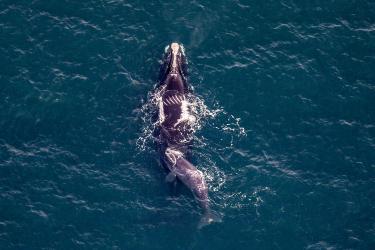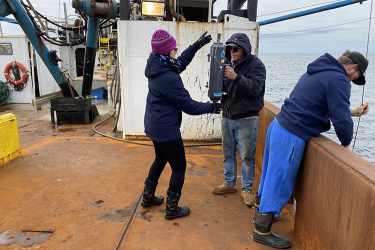In the fall of 2019, I went to sea to start collecting samples. In 2020, as COVID spread, federal research cruises were canceled one after another and this research came to a grinding halt. Cruises resumed slowly and we collected more water samples in the summer of 2021. Today I find myself at sea again, which completes my goal to sample in three different seasons.
I have been collecting environmental DNA samples on NOAA Ecosystem Monitoring (EcoMon) surveys since 2019. These samples will help develop eDNA metabarcoding, an innovative way to determine what fish species live in what parts of the ocean without actually seeing any fish.
As I write this post, I am aboard the NOAA Ship Henry B. Bigelow with the 2022 Spring EcoMon. The general survey region of EcoMon overlaps with NOAA bottom trawl surveys, which allows us to compare eDNA survey results with bottom trawl survey results. I am grateful to the EcoMon team to accommodate my sampling needs. “Piggybacking” on their surveys not only reduces the operational cost for eDNA work, but also gives me access to other data important to the interpretation of eDNA data, such as temperature, salinity, and ichthyoplankton composition.
How Does eDNA Metabarcoding Work?
Fish shed DNA into the surrounding environment. We “filter and fix” DNA molecules out of the seawater on the ship, then bring the filters back to the laboratory for DNA extraction. From the DNA on the filters, we create many copies of the different versions (representing different species) of a DNA segment.
We contract with the Cold Spring Harbor Laboratory to assemble all the DNA from different species using next-generation sequencing. Our goal is to find out what fish are present in the seawater without using a hook or net. Since eDNA metabarcoding identifies multiple species simultaneously, it works like another kind of fishing net. The unique strength of metabarcoding is that it allows us to identify fish that may be too small, too big, too fast, or too rare to collect with conventional sampling gear.
The EcoMon program has good spatial and temporal sampling coverage, so we also hope to derive information on the number of fish.
Collecting eDNA Samples on a Ship
On load-in day, we set up our filtration apparatus and secure everything so rough seas won’t create chaos.
When we get to a station, I first need to decide the depths from which to collect eDNA water samples. We securely attach environmental sensors to the bottom of a metal frame, which holds 24 10-L Niskin bottles arranged as a rosette. As the rosette goes down the water column, we acquire vertical profiles of chlorophyll a, temperature, and other parameters. As the rosette slowly rises back up, computers send commands to open the Niskin bottles so they fill with seawater at various depths.
After the rosette is back on deck, we transfer seawater from the different depths from the Niskin bottles into our sampling bottles.
We then take the sampling bottles back to one of the ship’s laboratories and start filtration. An air pump creates a low-pressure environment in a flask that sucks seawater through membrane filters to trap the DNA molecules.
Lastly, we put the filters into 2 mL sterile tubes and store the tubes in a deep freezer (-80°C/-112°) until we take them back to the lab for DNA extraction.
eDNA metabarcoding is an extremely sensitive method, so avoiding contamination is important when working in the field. We do not want to introduce fish signals from the environment (surfaces, air, human, etc.) into our samples, or from sample A to sample B. To achieve this, we wash our sampling bottles and filtration apparatus as thoroughly as we can with fresh water between samples. When time allows, we also decontaminate them in a diluted bleach solution to remove any residual DNA.
The entire process from rosette deployment to completing filtration is very time-consuming. Rosette deployment and retrieval can take from 20 to 50 minutes depending on the water depth at a station. The time to transfer seawater from Niskin bottles to sampling bottles can easily take 30 minutes with two people working. This is because we sample from as many as six different depths, and we collect duplicate samples at each depth. Lastly, filtering a single 2 liter sample can take up to 3 hours if particulates in the sample clog the membrane filter.
When sampling stations are close, meals can be rushed and sleep may be skipped, but every station is another opportunity to help shape the direction of eDNA research. For example, preliminary analysis of our 2019 samples showed us that 2 liters of seawater, compared to 1 or 3 liters, seemed to optimize the ratio of DNA signal over filtration time. In future analyses, I hope to better understand the vertical profiles of fish assemblages and reduce vertical sampling, if that can be backed up by data. We would also like to look into ways to simplify the filtration process. Stay tuned!
A Few Reflections
My Ph.D. training was in microbial oceanography, a field that routinely uses DNA metabarcoding to identify species. Microorganismal DNA is wrapped in cell membranes and is an integral part of the environment, which was probably why we didn’t specifically call it “environmental DNA” back then.
Working with fish, I am overwhelmed by all their Latin species names, appearances, and distributions. By one estimate there are more than 300 marine fish species off New Jersey alone. Fortunately, at the Northeast Fisheries Science Center, I can easily find answers to my questions from fisheries experts such as Dr. Richard McBride and Dr. David Richardson. We work closely to learn from other experts about how my research can help answer fisheries questions.
Today is June 3, 2022. We are heading south to the Mid-Atlantic Bight area after a brief interruption caused by a COVID case. The impact COVID has on surveys is tangible at all levels: planning, executing, and mitigating the situation when cases happen. Truthfully, though, we all cherish the opportunity to work closely together and collect valuable samples, and we are ready to do whatever it takes to continue the work. I will always remember these sea days.











